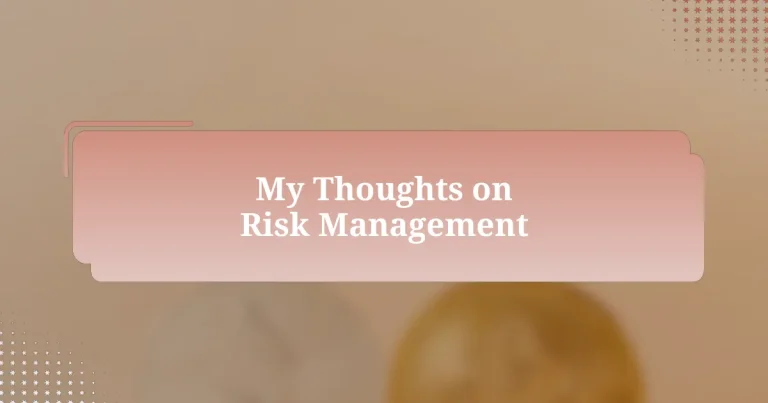Key takeaways:
- Risk management in DeFi involves identifying and prioritizing risks to maintain control and peace of mind.
- Common risks include smart contract vulnerabilities, liquidity risks, and market volatility, each requiring strategic responses.
- Diversification, setting stop-loss orders, and continuous education are essential strategies for effective risk management.
- Emotional discipline and community research are vital lessons learned to navigate the unpredictable nature of DeFi investments.
Understanding risk management
Understanding risk management is crucial, especially in the realm of Decentralized Finance (DeFi), where smart contracts and market volatility are part of everyday life. I remember my first foray into DeFi; the thrill was palpable, but so was the anxiety. It made me realize that, just like in traditional finance, understanding the potential pitfalls is key to navigating this innovative landscape.
In essence, risk management is about identifying, assessing, and prioritizing risks, followed by coordinated efforts to minimize or control the probability of unfortunate events. I often ask myself, what am I willing to lose? This question has guided my investment decisions and helped me maintain a balanced perspective in a space that can swing dramatically in a matter of hours. Having a risk management strategy isn’t just about numbers; it’s about peace of mind.
As I delve deeper into risk management, I find it’s not just a safety net; it’s also a compass that guides my investment decisions. For instance, when I think about liquidity risks in DeFi, I remember a time I missed out on a promising opportunity because I hadn’t considered how quickly a market could shift. This experience taught me to always have a plan, so I can act swiftly and confidently when the moment calls.
Common risks in decentralized finance
One of the most significant risks in decentralized finance is smart contract vulnerability. I recall a specific incident when a popular DeFi project was hacked due to a flaw in its code. The project lost millions, and I couldn’t help but think how easily that could have been me if I’d held tokens in that platform. It served as a stark reminder that diligence in smart contract auditing is essential; you can never be too careful when it comes to technology that manages your assets.
Another common risk is the liquidity risk, which can lead to significant slippage during times of market volatility. I experienced this firsthand when I attempted to sell a token during a downturn. The price plummeted, and by the time my transaction went through, I’d lost more than anticipated. This taught me to always assess liquidity before diving into a trade. It’s a lesson I carry with me: not all assets have the same potential for easy entry and exit.
Market volatility itself is an ever-present risk in the DeFi sphere. Some days, the fluctuations can feel exhilarating; other times, they’re downright nerve-wracking. This brings up a crucial question: how do I manage my emotions during such wild swings? I’ve found that establishing a clear strategy for when to take profits or cut losses can transform that anxiety into action, allowing me to engage with the market confidently, rather than reactively.
Strategies for effective risk management
When it comes to effective risk management in decentralized finance, diversification is a strategy I advocate strongly. I remember a time when I had most of my investments concentrated in one token; when the project faced negative news, I experienced monumental losses. Spreading investments across different assets not only mitigated my exposure to any single point of failure but also allowed me to benefit from various growth opportunities simultaneously.
Another critical strategy is setting stop-loss orders. I learned this lesson the hard way after holding onto a volatile asset for too long, only to see its value plummet overnight. Implementing stop-loss limits gives me peace of mind, as it acts as a safety net in unpredictable markets. Isn’t it reassuring to know there’s a plan in place to protect your funds, even when emotions run high?
Finally, continuous education cannot be overstated. Staying informed about market trends, regulatory changes, and emerging risks has helped me navigate the rapidly evolving DeFi space. I often find myself attending webinars or reading the latest research; each new piece of knowledge builds my confidence. How can you make informed decisions if you’re not aware of the landscape? It is crucial to commit to ongoing learning to enhance your risk management strategies effectively.
Lessons learned from DeFi experiences
There’s an undeniable lesson I learned from my early days in DeFi: the importance of community research. I recall a situation where I rushed into a project solely based on buzzwords and flashy marketing. The result? A hefty loss that could have been avoided if I had taken the time to engage with the community and gather insights. This made me realize how crucial it is to listen to the voices that are actually experiencing the project firsthand.
One experience that still resonates with me is the volatility during a major network upgrade. I was caught off guard while my assets were locked up, and I missed out on potential gains. It taught me the hard truth about maintaining liquidity and readiness for sudden market shifts. Have you ever been in a position where you felt powerless while your investments tied up in the uncertainty? It can be an unsettling feeling, and I’ve since made it a priority to ensure my assets are not only diversified but also accessible.
Lastly, I can’t emphasize enough how emotional discipline plays a role in risk management. There was a time I sold an asset in a panic, only to watch it rebound significantly shortly after. This experience instilled in me the importance of having a well-thought-out plan and sticking to it, regardless of the market’s whims. How often do we let fear steer our decisions instead of sticking to our research and strategies? Recognizing this tendency was a pivotal moment for me, transforming my approach to risk management in DeFi.

